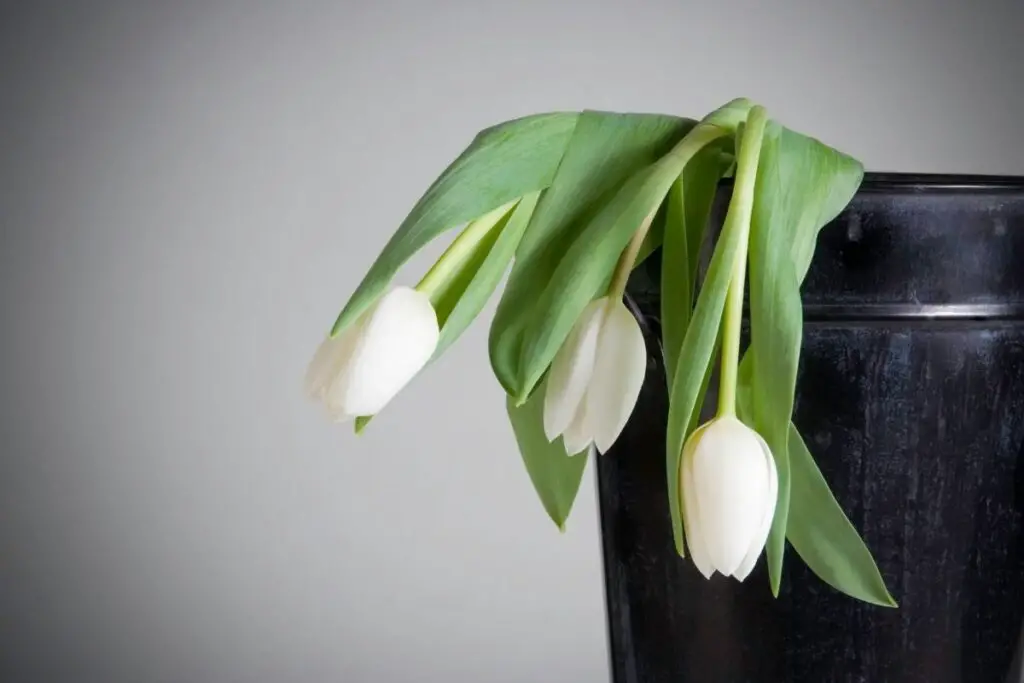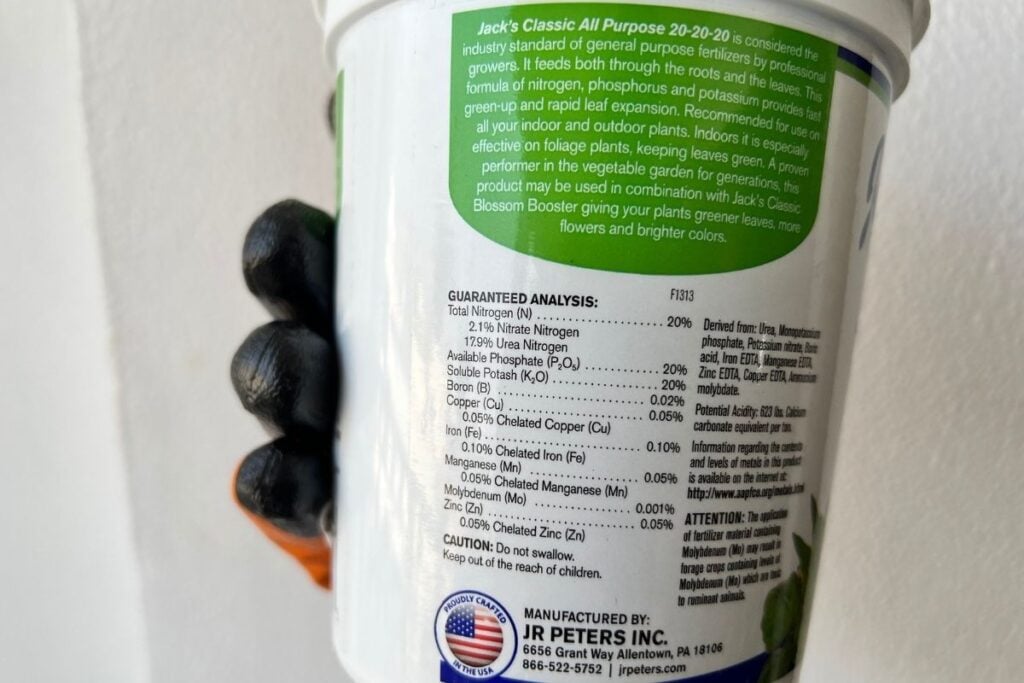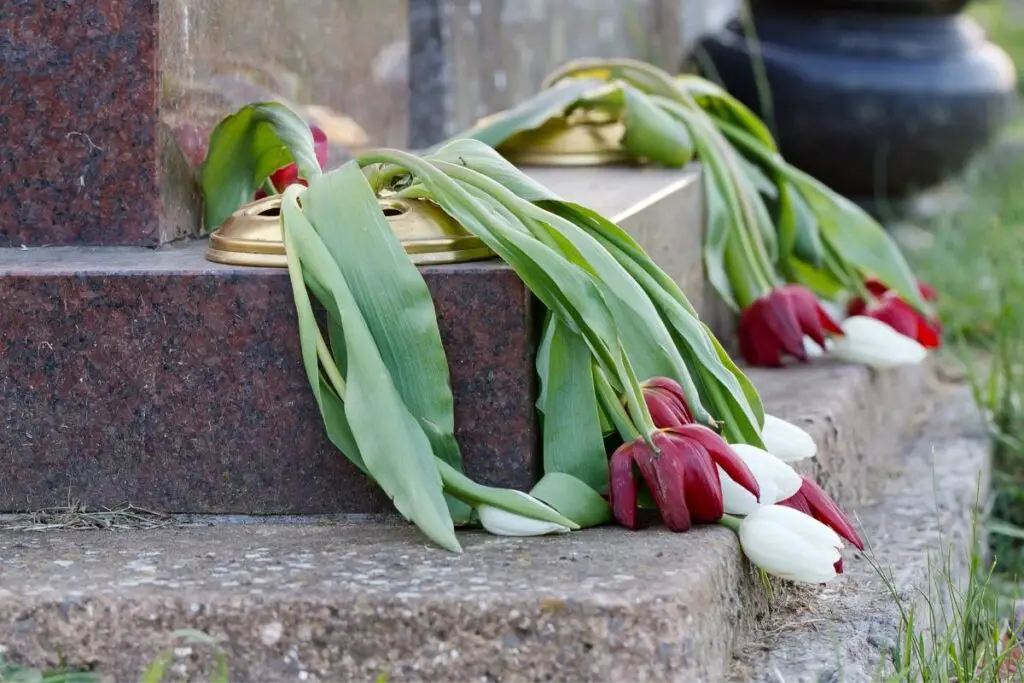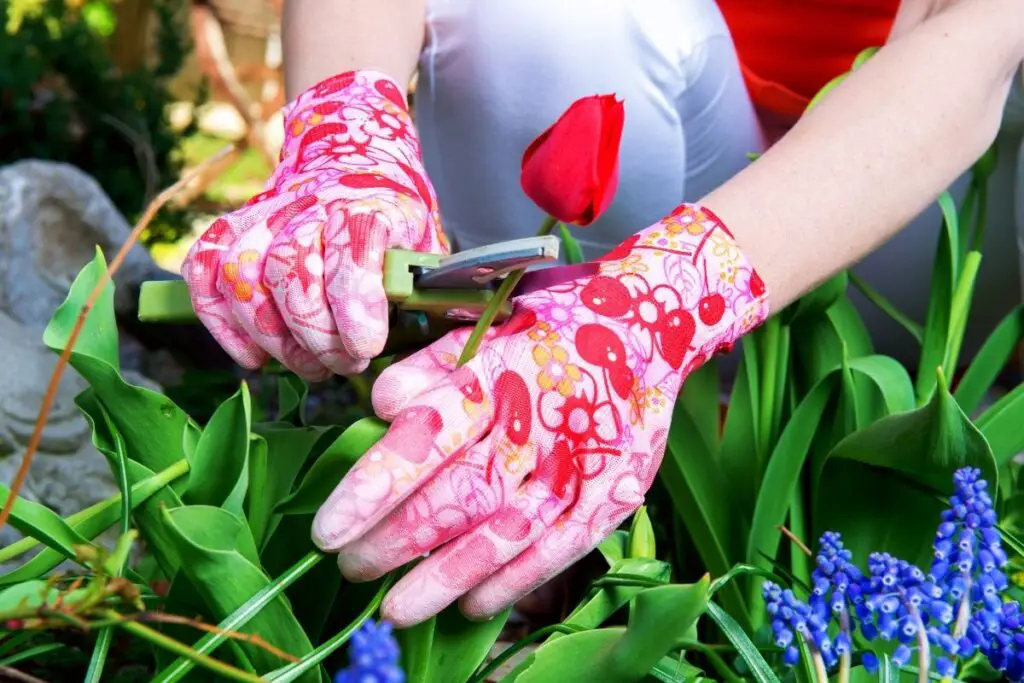Tulips bring a splash of colors to your garden. But, one usual problem growers always complain of is droopy tulips. Droopy tulips indicate tragic problems in the plant.
But why are your tulips drooping? Let’s find out.
Dehydration is the primary cause due to which your tulips are drooping. Lack of adequate watering or intense sunlight can dehydrate the tulip leading to droopy leaves. Besides that, overwatering can also lead to root rot which affects nutrient absorption leading to a droopy plant.
Today, in this guide, we will learn why tulips droop and how to perk up the tulips and prevent further drooping. So, let’s start.

Why are my tulips drooping?
Tulips have more than 100 varieties that add elegance and color to your garden. Most will flower in the early spring and bloom for days or weeks.
However, it is disheartening to see them droop, indicating they are not in good health. Unhealthy tulips will also stop flowering during their blooming time.
When you find droopy tulips in your garden, you must keenly observe the environmental conditions in the garden and the cultural problems they face.
Water issues
When tulips droop, the first thing that generally comes to mind is inadequate watering. They droop when they are thirsty. They will not like being dehydrated.
Even though tulips don’t need a lot of water, they need enough to remain moist. You don’t need to saturate the soil thoroughly.
Watering tulips correctly is not much of a problem. You just need to water the tulips once a week with 1 inch of water. That’s all.
Water the plant to keep the soil bed evenly moist whenever you find droopy tulips. You need to water them when the top 1 inch of the soil bed dries up.
Wait until the tulips absorb the water. Avoid watering in summers because tulips go dormant in summers.
Light and warmth
Tulips are photonastic and heliotropic plants because they move, bend, twist and arc according to the light intensity and sun’s path. When the tulips droop, they are not receiving enough light or are trying to get sunlight.
Along with light, they also need warmth to remain healthy. The tulip bulbs need a cold temperature before planting and before flowering to bloom fruitfully.
But, once they grow above the ground, they will require warmth.
Excessive cold weather can hurt the tulip’s cell walls, due to which the moisture escapes and stems lose their rigidity to stay straight. As a result, the tulips will droop.
However, once the cold temperature drops, they stand straight, provided the cells are not significantly damaged.
Ensure that the site you have chosen gets enough light. The site should be free from blockages like tall trees or buildings.
If it gets too cold, you can keep the tulips warm by adding a layer of mulch to the soil bed. This will work as an insulator.
Also read: How Much Sunlight Do Tulips Need? (Tulip Light Needs)
Temperature
Tulips tend to droop down if the temperature gets too hot or dry. If you live in a region where USDA hardiness zones are about 4 through 10, you will have to protect the tulips from the hot afternoons.
You can create a simple temporary shade for them where they can get bright light and at the same time protect them from the harsh, direct afternoon sun.
But, you will need to open the shade in the morning. They will love the morning sun.
Another reason behind droopy tulips is sudden temperature drop.
Planting the bulbs in the early fall may result in early sprouting. Still, when the temperature suddenly drops after the fall, these young tulips won’t be able to handle such a temperature suddenly and cause drooping.
As I mentioned earlier, you can add mulch. If you have planted the tulips in early fall and sprouted early, add a 1-2 inch layer of mulch. This will protect them from this sudden temperature drop.
As a rule of thumb, you need to plant the bulbs in the mid or late fall to let them remain underground in the low temperatures. This cold temperature will give the bulbs enough energy to flower profusely in the coming spring.
Also read: What Temperature Do Tulips Need? (+Growing Them At Different Temperature)
Looking for gardening supplies? We have tested 100's of products before recommending them to you guys. Check out our best pick below:
| Image | Gardening Supplies | Best Price? |
|---|---|---|
 Top
Top Top
Top | Raised Garden Bed Kit | Check On Amazon |
 | XLUX Soil Moisture Meter, Plant Water Monitor, Soil Hygrometer Sensor for Gardening, Farming, Indoor and Outdoor Plants, No Batteries Required | No Results |
 Top
Top Top
Top | 82 Pcs Garden Tools Set and Extra Succulent Tools Set | Check On Amazon |
 | Joeys Garden Expandable Garden Hose with 8 Function Hose Nozzle, Lightweight Anti-Kink Flexible Garden Hoses, Extra Strength Fabric with Double Latex Core, (50 FT, Black) | No Results |
 Top
Top Top
Top | Dual Chamber Compost Tumbler | Check On Amazon |
 Top
Top Top
Top | Sunnyglade Plant Stakes | Check On Amazon |
 Top
Top Top
Top | Organic Cold Pressed Neem Seed Oil | Check On Amazon |
 Top
Top Top
Top | Mighty Mint Gallon :-Insect and Pest Control Peppermint Oil | Check On Amazon |
 Top
Top Top
Top | Scotts DiseaseEx Lawn Fungicide | Check On Amazon |
 Top
Top Top
Top | Jacks Classic 20-20-20 All Purpose Fertilizer | Check On Amazon |
 Top
Top Top
Top | 30,000 Seeds Pollinator Attracting Wildflower Mixture | Check On Amazon |
 Top
Top Top
Top | Survival Vegetable Seeds Garden Kit-Over 16,000 Seeds | Check On Amazon |
Nutrition

Tulips don’t require much fertilizer because their bulbs already carry a lot of nutrients for vigorous spring flowering. But, a little extra booster by using a bulb fertilizer is never a bad thing.
If at any time, tulips lack nutrients, this fertilizer will avoid drooping the tulips.
The fertilizer will motivate the bulbs to store more nutrients for abundant flowering in the future. You can fertilize the tulips before the leaves turn yellow during the late spring or early summer.
Soil fertility is also responsible for droopy tulips. You can add organic ingredients to the soil bed to increase soil fertility naturally.
With proper nutrients, the tulips will not have any drooping problems. Even if it has, proper nutrition supply will bring them back.
Also read: What Is The Best Fertilizer For Tulips? (Organic+Inorganic)
Pests and fungus infestations
Pests and fungal attacks will result in droopy tulips because they make the plant unhealthy. They lose their energy to stand straight and thus turn droopy.
Diseases like tulip fire or Botrytis Tulipae target the leaves, and dead areas will be visible across the plant. This reduces the plant’s ability to perform good photosynthesis.
Without good photosynthesis, the leaves and stems will lose their strength and causes droopiness.
Pests like bulb mites feed on the bulbs and make them weak. The bulb thus loses its capability to support the plant for healthy stems, foliage, and flower growth.
These mites will gradually eat up the whole bulb, resulting in droopy stems and leaves.
You need to continue checking the plant when you find any signs of pests or fungus. You need to shower the plant with a suitable force that tulips can tolerate. Handpick to remove the remaining pests after shower.
Mist the affected areas with neem oil. This is useful for both pests and fungi.
Natural insecticidal soaps, like castile soap, can help get rid of bugs. Make a solution of this soap by mixing 5 tablespoons of the soap with 1-gallon water.
Before you apply this to the whole plant, try a sample test by spraying a small portion. Concentrate specifically in the infested area. If the plant’s reaction is positive, you can use it further.
Bugs like aphids can be naturally removed by releasing ladybugs. They will eat up all the aphids.
For severe infestations, you have to use pesticides to kill the pests in your tulips. For destroying fungal infections, you have to treat them with fungicides.
You can prevent pests and fungus by keeping the plant healthy and stressing them. Overwater, underwater, over-fertilization, and frequent disturbance of soil bed are some of the common reasons behind pest or fungal infections.
You can add compost to the soil bed to keep them nutritious. A nutritious soil will not attract bugs and funguses.
Also read: Bugs On Tulips: (Common Pests, Identification+How To Get Rid)
Lifecycle
Even though droopy tulips indicate that there has been some problem in the plant, those are not the only reason. There is one natural reason behind droopy tulips. The tulips will droop when their lifecycle ends.
When the tulips end their first cycle of flowering, they will droop. They droop because the plant has wholly utilized all the energy available from the bulbs to produce blooms. But don’t immediately start removing the leaves if they are still green.
These green leaves are still capable of photosynthesis. The bulb will continue to consume energy from these green leaves for next year’s flowering cycle. You can remove the spent flowers, though.
The leaves will droop, turn yellow, die, and automatically fall from the plant. Only after that can you dig up the bulbs for storing them and planting them again in the fall.
How to stop tulips from drooping?

The end of the lifecycle is an exception, but something is wrong when tulips droop. We need to check and control their environmental conditions in the garden to stop them from drooping.
Water tulips regularly
Watering the tulips regularly and avoiding drought conditions will keep the plant from drooping. When the top 1-inch soil bed feels dry, you can water the tulip bed with 1-inch water once a week.
You don’t have to damp the bed thoroughly. Water the tulips enough to keep them moist.
Keep checking their moisture level. This will help you to understand when they need water. With daily practice, it will be easy to handle.
Also read: How Often Do Tulips Need To Be Watered? (Tulip Watering Needs )
Add soil to the tulip bed.
Tulips like to be in firm soil to root and thrive. For improving the root structure, this extra soil needs to remain firm. Rich soil is not required.
When you see the tulips drooping, consider adding garden soil or loam soil around your tulips. Press the soil firmly until the ground seems packed and even.
Also read: What Kind Of Soil Is Good For Tulips? (Best Soil Mix)
Prune off spent flowers

You must remove the spent flowers. If you don’t remove the spent blooms, the plant will start focussing on growing seed pods in the tulips.
When the plant uses its energy on seedpods, the bulbs might not get the energy they need from the plant for the next blooming cycle.
Thus pinching off the dead flowers can save this energy and stop the tulips from drooping.
Give them shelter
As they grow in an open garden, they need to be sheltered to protect them from strong winds. The tulips don’t have quite strong stems to tolerate strong winds.
If your tulips are already bending a little, sudden strong winds will make them more droopy.
To protect them from strong winds, you can use plastic domes to shelter tulips and protect them from winds. You can also plant hedges or create a fence or physical barrier as shelter.
These protections might not be enough to save the plant from the winds, but they will limit the tulips damage to some extent.
Dig up the plants
An early and sudden cold temperature can make the tulips droop and kill the plant. In cold areas, when the temperature drops below -6.67°C, you have to protect them.
If you want to save your tulips, you need to dig them up and keep them indoors until the cold weather ends. Along with it, you can need to monitor the temperature indoors.
How to prevent tulips from drooping in a vase?

If you have tulips in a vase and they are drooping, you can follow the following steps to keep them perk up:
Cut back the stems while they are in the water. They keep growing after they are cut for the vase.
Trimming by 3 to 5 centimeters will stop them from being droopy. Cut at an angle. This will prevent the entering of gas bubbles into the plant.
Pin them up. Stick a pin through the tulip stems just under the flowers. This is said to have a similar effect to stem cutting. You can also wrap them with newspaper to avoid drooping.
To fix the problem quickly, cut the stems and put them in cold water. This will help them perk up for some time. However, you should do this rarely.
Daily practice of this method can harm them and reduce their lifespan.
Give them food. Mix a tablespoon of sugar, ¼ tablespoon of household bleach, and two tablespoons of lime juice with ½ to 2 cups of warm water.
Change the vase water every few days. Tulips hate dirty water and will turn droopy if water is not changed. While changing the water each time, cut the tulip stem by 1 cm.
Clean the vase with antibacterial soap before putting the tulips in it.
Indoors don’t keep them under direct sun. Let them have filtered sunlight. Keep them away from air conditioners, radiators, and fruits.
Final thoughts
Droopy tulips can be fixed if initiatives are taken quickly. They are easy to fix, and they will come back soon with proper care. Water them once a week with 1-inch water to keep them from thirst.
Ensure that they receive a good amount of sunlight. Protect them from the harsh afternoon sun and strong winds by creating shelters in the garden bed. You don’t need to feed the tulips too much. You can fertilize them once a year, after planting, in the fall.
Check out for pests and fungus attacks in the plant. Whenever you find any symptoms, take steps quickly to get rid of them and save the plant from droopiness.
However, you cannot do anything about the natural drooping of tulips. When their lifecycle ends, the tulips will droop naturally. Wait until the leaves die, and then you can dig up the bulbs, store them and plant them again for abundant flowering in the next year.
Source: Wikipedia, North Dakota Stae University, The Royal Horticultural Society.
